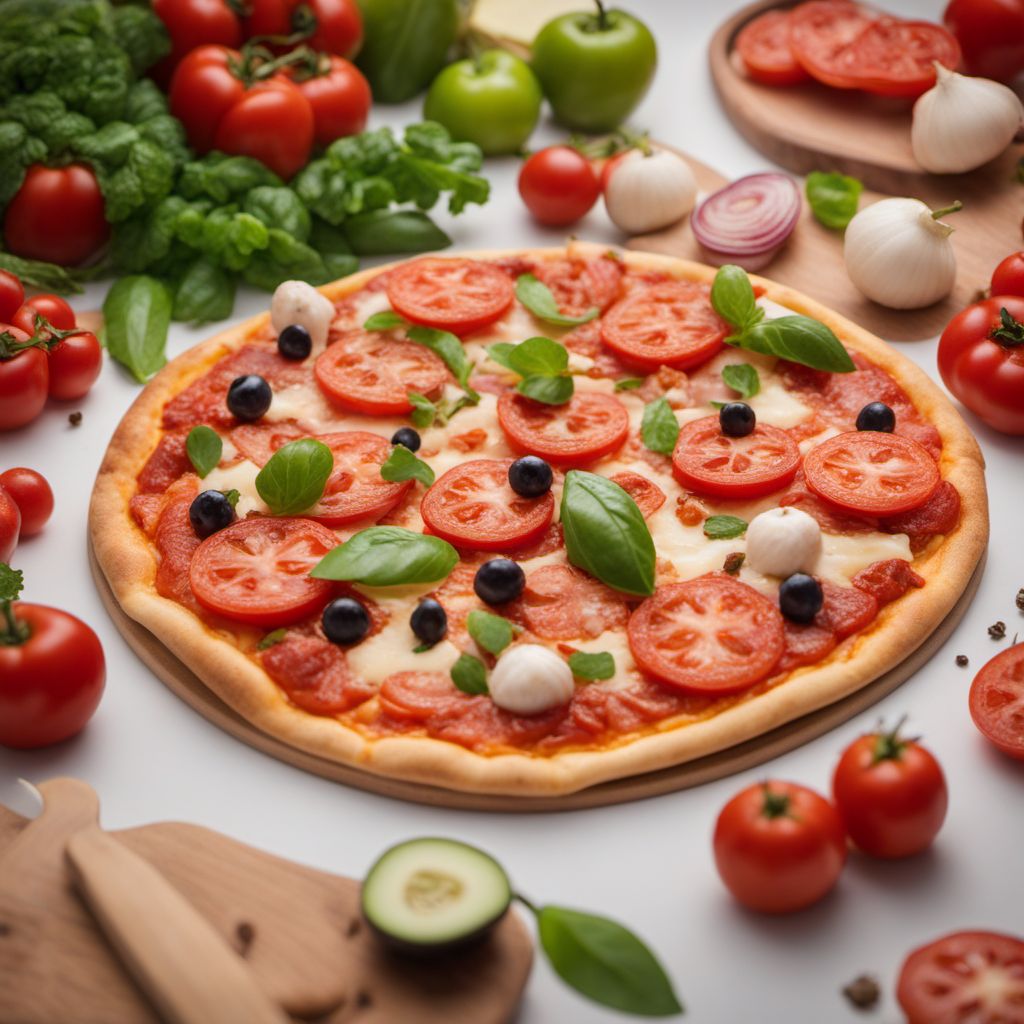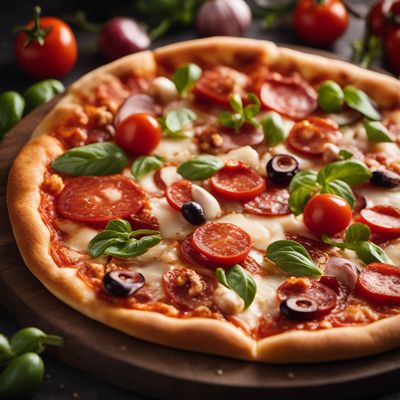
Ingredient
Pizza and similar with cheese, and vegetables and fruits
The Perfect Medley: Unveiling the Harmonious Blend of Cheese, Vegetables, and Fruits in Pizza and Similar Creations
Pizza and similar dishes are characterized by a thin or thick crust topped with a variety of ingredients, including cheese, vegetables, and fruits. The crust can be crispy or chewy, while the cheese adds a creamy and savory element. The vegetables and fruits provide freshness, vibrant colors, and a burst of natural sweetness. The combination of these ingredients creates a harmonious balance of flavors and textures, making each bite a delightful experience.
Origins and history
Pizza, as we know it today, originated in Naples, Italy, in the late 18th century. It was initially a simple dish made with flatbread topped with tomatoes, garlic, and olive oil. Over time, cheese, vegetables, and fruits were added to enhance the flavors and create a more substantial meal. Pizza gained popularity in the United States in the late 19th and early 20th centuries, thanks to Italian immigrants. Today, it has become a global phenomenon, with countless variations and regional adaptations.
Nutritional information
Pizza and similar dishes can vary widely in their nutritional content depending on the specific ingredients used. They can provide a good source of carbohydrates from the crust, protein from the cheese, and a range of vitamins and minerals from the vegetables and fruits. However, it is important to note that the overall nutritional value can be influenced by factors such as the type and amount of cheese, the thickness of the crust, and the quantity of toppings.
Allergens
Pizza and similar dishes may contain allergens such as gluten (from the crust), dairy (from the cheese), and various fruits and vegetables that can cause allergic reactions in some individuals. It is essential to check the ingredients and inform the server or chef about any allergies or dietary restrictions.
How to select
When selecting pizza or similar dishes, look for establishments that use fresh, high-quality ingredients. The crust should be well-baked, with a golden color and a crisp or chewy texture, depending on your preference. The cheese should be melted and evenly distributed, while the vegetables and fruits should be vibrant in color and have a fresh appearance. Additionally, consider the reputation and reviews of the establishment to ensure a satisfying culinary experience.
Storage recommendations
Leftover pizza should be stored in an airtight container in the refrigerator to maintain its freshness. It is best consumed within 2-3 days. To reheat, place the pizza in a preheated oven or toaster oven to restore its crispness. Alternatively, a microwave can be used for a quick reheating, although the crust may become slightly softer.
How to produce
Amateur cooks can produce pizza and similar dishes by making their own dough, selecting their preferred cheese, and choosing a variety of vegetables and fruits for toppings. There are numerous recipes and tutorials available online that provide step-by-step instructions for making homemade pizza. With practice and experimentation, one can master the art of creating delicious and personalized pizza creations.
Preparation tips
To prepare pizza, preheat the oven to the recommended temperature and place the pizza directly on the oven rack or a preheated pizza stone for a crispier crust. For a softer crust, use a baking sheet. Experiment with different combinations of cheese, vegetables, and fruits to create unique flavor profiles. Consider adding fresh herbs, spices, or drizzling with olive oil for added depth of flavor. For a healthier option, opt for whole wheat or cauliflower crust and use a lighter cheese or less cheese.
Culinary uses
Pizza and similar dishes are incredibly versatile and can be enjoyed as a main course, appetizer, or even as a snack. They are commonly served at pizzerias, restaurants, and casual gatherings. Pizza can be customized with a variety of toppings, including different cheeses, vegetables, and fruits, allowing for endless culinary creativity.
Availability
Pizza and similar dishes are widely available in countries around the world. They can be found in pizzerias, Italian restaurants, and even fast-food chains. The popularity of pizza has made it a staple in many cuisines, and variations can be found in various regions.
More ingredients from this category

Pizza and similar with cheese, and mushrooms
The Perfect Combination: Cheese and Mushrooms on a Pizza

Pizza and similar with cheese, meat, and vegetables
Savory Delights: Exploring the World of Pizza

Pizza and similar with cheese topping
Cheesy Delights: Pizza and More

Pizza and similar with meat, and vegetables
Savory Delights: Exploring the World of Meat and Vegetable Pizzas

Pizza and similar with cheese, meat, mushrooms, and vegetables
Savory Medley: Exploring the World of Pizza and its Tantalizing Toppings

Pizza and similar with processed meat topping
Savory Delights: Exploring the World of Meat-Topped Pizzas

Pizza and similar with cheese, and vegetables
The Classic Combination of Cheese and Vegetables

Pizza and similar with cheese, meat, and mushrooms
Savory Delights: Exploring the World of Cheesy, Meaty, and Mushroomy Pizzas

Pizza and similar with fish/seafood topping
Oceanic Delights

Pizza and similar with vegetable topping
Veggie Delight